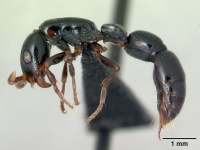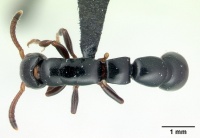Simopone merita
| Simopone merita | |
|---|---|

| |
| Scientific classification | |
| Kingdom: | Animalia |
| Phylum: | Arthropoda |
| Class: | Insecta |
| Order: | Hymenoptera |
| Family: | Formicidae |
| Subfamily: | Dorylinae |
| Genus: | Simopone |
| Species group: | emeryi |
| Species: | S. merita |
| Binomial name | |
| Simopone merita Bolton & Fisher, 2012 | |
The type specimen was collected from a Malaise trap in montane rainforest.
Identification
A member of the emeryi species group.
Keys including this Species
Distribution
Latitudinal Distribution Pattern
Latitudinal Range: -14.75° to -14.75°.
| North Temperate |
North Subtropical |
Tropical | South Subtropical |
South Temperate |
- Source: AntMaps
Distribution based on Regional Taxon Lists
Malagasy Region: Madagascar (type locality).
Distribution based on AntMaps
Distribution based on AntWeb specimens
Check data from AntWeb
Countries Occupied
| Number of countries occupied by this species based on AntWiki Regional Taxon Lists. In general, fewer countries occupied indicates a narrower range, while more countries indicates a more widespread species. |

|
Estimated Abundance
| Relative abundance based on number of AntMaps records per species (this species within the purple bar). Fewer records (to the left) indicates a less abundant/encountered species while more records (to the right) indicates more abundant/encountered species. |

|
Biology
|
Castes
Nomenclature
The following information is derived from Barry Bolton's Online Catalogue of the Ants of the World.
- merita. Simopone merita Bolton & Fisher, 2012: 57, figs. 58-60 (w.) MADAGASCAR.
- Type-material: holotype worker.
- Type-locality: Madagascar: 9.2 km.WSW Befingotra, Res. Anjanaharibe-Sud, 14°45’S, 49°28’E, 1280 m., 13-12 (sic).xi.1994, BLF1155-4, CASENT0004543, Malaise trap, montane rainforest (B.L. Fisher).
- Type-depository: CASC.
- Distribution: Madagascar.
Unless otherwise noted the text for the remainder of this section is reported from the publication that includes the original description.
Description
Worker
Holotype. HL 1.64, HW 1.11, SL 0.52, EL 0.43, PW 0.88, AIIW 0.84, AIIL 0.83, AIIIW 0.95, AIIIL 1.00, WL 1.74, MFL 0.93, CI 68, SI 47, EL/HW 0.39, EP 0.96, AIIW/AIIL 1.01, AIIIW/AIIIL 0.95.
In full-face view anteriormost points of frontal lobes do not conspicuously project beyond the level of the anterior clypeal margin. Eyes located close to cephalic midlength (EP 0.96). Leading edge of scape with 3–4 projecting long setae that are inclined toward the scape apex. In full-face view sides of head from level of eyes to clypeus with a few laterally projecting setae that arise from close to the vetrolateral margin of the head; sides behind eyes without projecting setae. In profile cephalic dorsum with two inconspicuous standing short setae that arise just above the eye; setae distinct on ventral surface of head. Cephalic dorsum between eyes densely punctate and with dense, longitudinally arranged, roughly striolate ground sculpture. Behind the eyes the ground sculpture fades out, but anteriorly it extends forward between the frontal carinae. In dorsal view the pronotum with a transverse carina anteriorly. Propodeal dorsum meets declivity through a narrowly rounded angle, without trace of a carina. Promesonotal suture shallow but distinct, metanotal groove vestigial to absent. Mesosoma in dorsal view with mesonotum slightly narrower than both pronotum and propodeum. Punctate sculpture on pronotal dorsum much more dense than on mesonotal dorsum; punctures on central area of mesonotum especially sparse so that the vast majority of the surface appears smooth. Pronotum with a single pair of setae close to the humeri; mesonotum and propodeum without setae. Dorsal (outer) surfaces of mesotibiae and metatibiae with one or two projecting setae near their apices. Dorsal surface of AII (petiole) meets anterior surface in a narrowly rounded angle, without a transverse carina. Posteriorly the dorsum of AII has a low transverse ridge above the foramen. In dorsal view the posterior corners of AII are bluntly angulate but do not project as teeth. In dorsal view AII about as long as broad; AIII slightly longer than broad. Dorsal surfaces of abdominal tergites AII to AIV without setae, but setae present on sternites of AIII and AIV. Grey pubescence conspicuous on sternite of AIII. Abdominal tergites AII to AIV sculptured only with small punctures. Full adult colour black; appendages and clypeus lighter, and with a dull red spot on the side of the pronotum and on the side of the tergite of AIII.
Type Material
Holotype worker, Madagascar: 9.2 km WSW Befingotra, Res. Anjanaharibe-Sud, 14°45’S, 49°28’E, 1280 m, 13–12 (sic).xi.1994, BLF1155-4, CASENT0004543, Malaise trap, montane rainforest (B.L. Fisher) (California Academy of Sciences).
References
- Bolton, B. & Fisher, B.L. 2012. Taxonomy of the cerapachyine ant genera Simopone Forel, Vicinopone gen. n. and Tanipone gen. n. (Hymenoptera: Formicidae). Zootaxa 3283, 1–101 (doi:10.11646/zootaxa.3283.1.1).
References based on Global Ant Biodiversity Informatics
- Bolton B., and B. L. Fisher. 2012. Taxonomy of the cerapachyine ant genera Simopone Forel, Vicinopone gen. n. and Tanipone gen. n. (Hymenoptera: Formicidae). Zootaxa 3283: 1-101.

